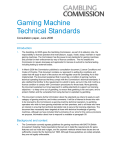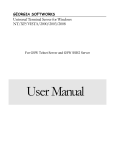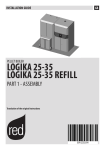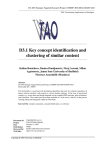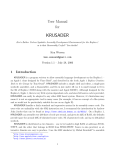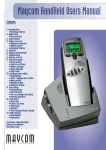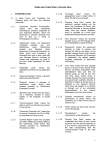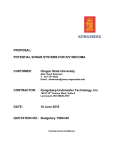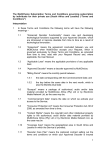Download gaming machine technical standards - category b3a
Transcript
Machine Standards Category B3A June 2008 Contents Introduction 4 Other relevant gaming machine technical standards and related documents Section 1 Hardware requirements 5 Physical security Machine identification Gaming machine alarm/alert requirements Logic area Configuration settings Video monitors/touch screens Mechanical devices used for displaying of lottery outcomes Patch wires Section 2 Software requirements Critical memory requirements Contents of critical memory Maintenance of critical memory Program memory, critical memory and non-volatile devices used to store program memory Unrecoverable critical memory Function of critical memory reset Section 4 Machine credit and payment requirements Coin or token and note acceptors and other methods of inserting money or money’s worth into the machine Tokenisation Printers Ticket validation Section 5 Specific lottery requirements 7 7 7 7 7 8 9 9 9 9 10 10 11 11 11 11 11 12 General requirement Class size and chance distribution within a class Single lottery chance requirements Initiating the next lottery chance (auto start/play) Speed of play Multiple lotteries on gaming device Section 6 5 5 5 5 5 6 6 6 7 Control program authentication requirements Alterable storage media devices Program storage medium identification Last lottery chance recall Test/diagnostic mode Software verification Section 3 4 Specific error conditions and alert requirements General alert requirements Printer error conditions Note acceptor error conditions 12 12 13 13 13 13 15 15 15 15 2 Section 7 Meter requirements 16 Credit/play meter Accounting and occurrence meters Section 8 16 16 Artwork and game display requirements Information to be displayed Multi-line pseudo ‘games’ Display notice requirements Section 9 17 17 17 17 Definitions 19 3 Introduction This standard is applicable to category B3A gaming machines as defined in Article 5 of The Categories of Gaming Machine Regulations 2007. Category B3A gaming machines manufactured before 27 December 2008 will need to comply with all parts of the relevant standard by 27 June 2009. Category B3A gaming machines manufactured from 27 December 2008 will need to comply with all parts of the relevant standard before they are supplied into the market. The purpose of the standard is to set out in detail the Gambling Commission’s (the Commission’s) requirements with respect to game features, display notices and general machine operation including metering. These have been developed to help ensure the Commission’s three licensing objectives are met. Those objectives are to: • prevent gambling from being a source of crime or disorder, being associated with crime or disorder or being used to support crime • ensure that gambling is conducted in a fair and open way • protect children and other vulnerable persons from being harmed or exploited by gambling. Operators or end users should not rely upon these standards as a measure of reliability, quality or minimal security standards. These standards permit equivalence between different types of technology and do not specify proprietary products or technologies. Testing regimes for these standards will permit equivalent international standards (ISO). Whilst what is provided on a B3A machine must be a lottery, it is not intended further to limit game content and the use of new technological developments provided that the objectives of the standards are met. Other Relevant Gaming Machine Technical Standards and related documents • • • • Technical Standard for Server Networked & Downloadable Gaming Machines (All categories of machine) Technical Standard for Wireless Network Systems (All categories of machine) Technical Standard for Cashless Systems (All categories of machine) Gaming machines testing strategy 4 1.0 Hardware requirements 1.1 Physical security All reasonable efforts should be made to ensure that a gaming machine is robust enough to withstand forced entry which would not leave behind evidence of the attempted entry. Where any form of attempted or forced entry causes an error condition, the machine must only commence play once the error condition has been cleared. Provided that any security device or sensor (eg door open sensor) which has detected an attempted entry no longer indicates there to be a problem the machine may automatically clear the error condition and commence play. Otherwise, operator action shall be required to clear the error condition. 1.2 Machine identification A gaming machine must have an identification plate of metallic construction or of an equally resilient material permanently affixed to the exterior of the cabinet by the manufacturer. This must not be easily removable, without leaving evidence of tampering. The following information shall be displayed on the identification plate: a. the manufacturer (machine manufacturer or brand name under which it is to be sold) b. a unique serial number c. the gaming machine model number (which may refer to the cabinet type and not the lottery) d. the date of manufacture. The identification plate shall be mounted on the front or side of the cabinet where it is clearly visible. 1.3 Gaming machine alarm/alert requirements Gaming machines must be designed to automatically prevent further play within the lottery and alert the site management in the following situations: a. a player winning an amount or redeeming credits that the machine cannot automatically pay b. an error condition occurring c. a machine fault occurring. Such a system must be transparent to the player when activated and sufficiently able to attract the attention of the site management. 1.4 Logic area Manufacturers must so far as is reasonably practicable, incorporate gaming machine design features aimed at preventing tampering with any electronic logic components that has the potential to significantly influence the operation of the gaming device. 1.5 Configuration settings All switches and/or jumpers must be fully documented and any hardware system within the machine which may alter the configuration settings such as accounting denomination must either be housed within a separately locked secure logic area or comply with the following paragraph. As an alternative to a separate secure logic area, any change in configuration defined above must be logged and date stamped within the secure non-volatile memory of the machine. This log must cover a minimum period of not less than one month and be made available for display on demand with the test and diagnostic routine of the machine. 5 1.6 Video monitors/touch screens All video based lotteries shall meet the following requirements: a. touch screens shall be accurate and, once calibrated, shall maintain that accuracy for at least the manufacturer’s recommended maintenance period b. a touch screen should be able to be re-calibrated without access to the machine cabinet other than opening the main door c. there shall be no hidden or undocumented buttons/touch points anywhere on the screen that affect play within the lottery, except as provided for by the lottery rules d. section (1.6 c) does not apply to audit functions and controls which must be documented. 1.7 Mechanical devices used for displaying of lottery outcomes If the machine has mechanical or electro-mechanical devices, which are used for displaying lottery outcomes, the following rules shall be observed: a. mechanical assemblies (eg reels or wheels) shall have some mechanism that ensures the correct mounting of reels’ artwork b. displays shall be constructed in such a way that winning symbol combinations match up with pay lines or other indicators c. a mechanical assembly shall be so designed that it is not obstructed by any other components. 1.8 Not applicable to this category of machine 1.9 Patch wires All patch wires and track cuts shall be documented, in an appropriate manner, in the relevant service manual and/or service bulletin. This does not prohibit required repairs in the field. 6 2.0 Software requirements 2.1 Control program authentication requirements The control program must utilise an integrity check, suitable for the media, providing at least the level of integrity of CRC16 (for non-alterable storage media) or a secured hashing method such as MD5 or SHA (for alterable storage media) to authenticate that the program and/or support files have not been corrupted or altered prior to use/loading. Any error detected will result in the machine displaying the appropriate error message and being unavailable for play. The integrity check must be carried out during each start up or at least once every 24 hours where the machine is specifically designed for permanent serviceable operation. 2.2 Alterable storage media devices Any gaming machine and any procedural requirements must include sufficient security to ensure that any software that can influence the lottery outcome, including configurable settings and classes that reside on any alterable media is a true replication of that version of the lottery, control or other software. 2.3 Program storage medium identification Any program medium (ROMs, EPROMs, Alterable storage media, DVD and CD-ROM) placed in the field shall be uniquely identified, displaying: a. program ID number b. manufacturer or lottery system provider c. version number d. type and size of medium (unless located on the medium as purchased unused from the supplier) e. location of installation in gaming machine or device, if potentially confusing. The information a) to e) above must be available for inspection on the site operator’s premises either on the label of the storage media or via video or display monitor. For EPROM based lotteries, the identification label shall be placed over the UV window to avoid erasing or alteration of the program. 2.4 Not applicable to this category of machine. 2.5 Last lottery chance recall Information on at least the last fifty lottery tickets purchased on the machine must always be retrievable on the operation of a suitable external key-switch, or another secure method not available to the player. This information must include a minimum of which lottery has been entered (but only if several exist on the machine), timestamp of ticket purchase, unique ticket identifier (if system uses one), bank/credit meter details and outcome (losing chance or win amount). 2.6 Test/diagnostic mode When a gaming machine is in a test mode, any test that involves credits entering or leaving the gaming machine must be completed prior to resumption of normal operation. The main cabinet door of a gaming machine may automatically place the machine in a service or test mode. Test/diagnostics mode may also be entered, via an appropriate instruction, by an attendant during an audit mode access. When exiting from test mode, any lottery in play must return to the original state it was in when the test mode was entered. If the gaming machine is in a test mode, the machine must clearly indicate that it is in a test mode, not normal play. 7 2.7 Software verification At a minimum, the machine must have the ability to allow a visual inspection of the following using either an available matrix or video display. (It is permissible for the machine not to display such information during each start up but it must be accessible when required. This may involve the machine being restarted or an appropriate security key being used.) a. identity of the lottery system provider b. lottery system identity code c. version number of lottery system software d. check sum of lottery system software And if the operating system is not proprietary to the manufacturer, lottery system provider, supplier or operator then: e. identity of operating system f. version number of operating system On machines or terminals, which offer the player a choice of lotteries, the above information concerning the lottery software must be made available for each lottery. 8 3.0 Critical memory requirements 3.1 Contents of critical memory Critical memory (that is non-volatile computer memory) must be used to store a minimum of the following data: a. credit and bank values b. electronic meters (if so fitted) c. previous lottery ticket data, as required by section 2.5 The clearing or resetting of such data must require deliberate action by appropriately authorised personnel. 3.2 Maintenance of critical memory Critical memory storage must be maintained by a methodology that enables errors to be identified and corrected in most circumstances. This methodology may involve signatures, checksums, partial checksums, multiple copies, timestamps and/or effective use of validity codes. Comprehensive checks of critical memory must be made during each gaming machine or device restart (eg power up cycle). Gaming machine or device control programs (software that operates the machine or device’s functions) shall test for possible corruption caused by failure of the program storage medium and all critical lottery files. Test methodology must endeavour to detect 100 percent of all possible failures. The control program (software that operates the gaming machine or device’s functions) shall allow for the machine or device to ensure the integrity of all control program components during execution of said components. All program storage devices (PSD), in the executable address space of a main processor, shall be validated (including an integrity check of all lottery chance classes) during the following conditions: a. any power up b. the first time the files are loaded for use (even if only partially loaded). Memory and PSD space that are not critical to machine security (eg video or sound ROM) are not required to be validated. 3.3 Program memory, critical memory and non-volatile devices used to store program memory The following are requirements for critical memory: a. a battery back-up (where required), or an equivalent, must be installed on the gaming machine or device for the electronic meters and must be capable of maintaining the accuracy of all information required for thirty days after power is discontinued from the machine The battery backup device must be kept within the locked logic area or if not available in a secure location behind the locked main door b. if the rechargeable battery back-up is used as an ‘off chip’ battery source, it shall re-charge itself to its full potential in a maximum of twenty-four hours and have a shelf life of at least five years c. critical memory that uses an off-chip back-up power source to retain its contents when the mains power is switched off must have a detection system which will provide a method for software to interpret and act upon a low battery condition, or alternatively, use a suitable software check to ensure integrity of the storage is maintained. 9 3.4 Unrecoverable critical memory An uncorrectable corruption of critical memory must result in an error condition. Critical memory should not be cleared automatically, but must only be cleared by an authorised person. 3.5 Function of critical memory reset Clearing critical memory must only be capable of being undertaken by accessing the logic area or secure location in which it is housed. Following the initiation of a critical memory reset procedure, the lottery program must execute a routine which initialises each and every bit in memory to the default state. For machines that allow for partial critical memory clears, the methodology for doing so must be accurate and the machine must validate the un-cleared portions of memory. If a pseudo ‘game’ is used to display the result of the ticket , the default reel position or lottery ‘game’ display after a critical reset must not be the top award on any selectable line. The default lottery ‘game’ display, upon entering lottery ‘game’ play mode, must also not be the top award. This applies to the base lottery ‘game’ only and not to any secondary bonus devices. 10 4.0 Machine credit and payment requirements 4.1 Coin or token and note acceptors and other methods of inserting money or money’s worth into the machine All coin/token acceptors must meet the following requirements: a. the coin/token acceptor must be designed to prevent the use of cheating methods such as slugging (counterfeit coins/tokens), stringing (coin pullback), the insertion of foreign objects and other manipulation b. other than for diagnostic purposes coins/tokens judged invalid by the acceptor must be rejected to the coin tray and shall not be counted as credits. Acceptance of coins/tokens for crediting to the credit meter must only be possible when the gaming machine is enabled for play. Other states, such as error conditions, including ‘door open’ and ‘audit mode’ must disable the coin/token acceptor system. Each coin/token inserted must register the actual monetary value or a number of credits on the player's credit meter for the current lottery. If coins or tokens inserted in a machine are registered directly as credits, the conversion must be clearly stated, or be easily ascertainable from a help menu or similar. All acceptance devices must be able to detect the entry of valid notes, coupons, paper tokens, or other approved vouchers, and provide a method to enable the gaming device software to interpret and act appropriately upon a valid or invalid input. Acceptance devices must be electronicallybased and be configured to ensure that they only accept valid banknotes, vouchers or paper tokens and reject all other notes. The note input system must be constructed in a manner that protects against vandalism, abuse, or fraudulent activity. 4.2 Tokenisation For lotteries that may be played using tokens, the gaming machine or relevant device must receive from the acceptor and post to the player’s ‘bank’ the entire amount inserted. If the current local currency amount is not an even multiple of the token for a lottery or the credit amount has a fractional component, the system must retain the value for the benefit of the next player. 4.3 Printers If a gaming machine is equipped with a printer that is used to make payments, the printer must be located in a locked area of the machine (eg require opening of the main door to access), but not in the logic area unless the alternative requirements in the second paragraph of section 1.5 (configuration settings) are complied with. Any printed ticket/voucher/hand pay receipt must display the following information in addition to that required by the provisions of the Gambling Act 2005 (the Act) which apply to the particular type of lottery concerned (eg: a private society lottery or small society lottery): a. date and time (24-hour format) of issuance b. alpha numeric currency amount c. validation number and/or unique identifier (eg bar code) d. duplicate ticket indicator (eg duplicate number 3). 4.4 Ticket validation Payment by ticket printer as a method of credit redemption is only permissible when: a. there is a means to validate the printed ticket/voucher/hand pay receipt prior to any credit or other type of redemption b. such validation system is capable of identifying duplicate tickets to prevent fraud by reprinting and redeeming a ticket previously issued. To meet this standard, an audit trail of at least one month’s data relating to all ticket transactions must be maintained for dispute resolution purposes. 11 5.0 Specific lottery requirements 5.1 General requirement The outcome of the lottery must not be determined or influenced by means of the machine. To stop a class before it has completed there must be a valid reason such as evidence of fraud or manipulation. A class may only be suspended, stopped or replaced by a new class by a secure operator action. However, it is permissible for a machine to randomly select a new class of lottery tickets (when the current class is completed) from a previously randomised selection of classes, which have been pre-loaded into the machine, but the new class selected must be different from the class just completed. This requirement that the new class selected must be different from the class just completed only applies to machines that are manufactured from 27 December 2008. The machine must clearly display to the player either at all times when it is in operation or at the point a lottery is selected for play the following statement: THIS IS A LOTTERY MACHINE 5.2 Not applicable to this category of machine 5.2A Class size and chance distribution within a class Class sizes within any lottery must contain a minimum number of chances, with chances awarding wins (ie winning tickets) randomly distributed among the chances not awarding wins (ie losing tickets). The minimum number of chances depends on how the next class is selected: a. if the next class is selected from a limited number of re-usable classes then the minimum class size is 10,000. The number of classes from which a re-useable class is selected from must be sufficient to provide a reasonable assurance that there is no possibility that a payer or observer is able to predict the order in which chances have been randomised within a class. b. if the next class is not selected from a limited number of re-usable classes (eg a new class is downloaded from a server each time) then the minimum class size is 1,000 chances. The randomisation process must: c. ensure chances which award prizes and the value of those prizes are randomly distributed over the entire range and pass appropriate statistical tests d. ensure prize awards are randomly distributed over the entire range e. ensure the output is unpredictable f. not reproduce the same output stream, nor must two instances of an RNG produce the same stream as each other. Where seeding is required to achieve this it should not introduce predictability. A machine or device must not present a losing lottery ticket result which indicates a ‘Near Miss’, eg where the odds of the top award symbol landing on the pay line are limited it must not frequently appear above or below the pay line. If a gaming machine uses a pseudo ‘game’ to display the result of a lottery ticket which is recognisably a known game (eg poker, reels, bingo) and is described as such by title or visual presentation, it must be made clear to the player that the chances of winning in the lottery differ from an equivalent real game and that the outcome of the ‘game’ is totally dependant upon the result obtained from the next chance drawn from the class. 12 5.3 Not applicable to this category of machine 5.4 Not applicable to this category of machine 5.5 Single lottery chance requirements The price for any lottery ticket purchased by the player must be deducted from the credit or play meter prior to the outcome of the chance in the class represented by that ticket being displayed to the player. This section does not preclude the use of multi-line and multi-reel pseudo ‘games’ to display the result of the lottery ticket(s) provided that the aggregate ticket price and total prize do not exceed the statutory maxima . 5.6 Initiating the next lottery chance cycle (auto start/play) Except where an ‘auto play’ or ‘auto start’ feature is permissible1 it must always be necessary to release and then depress the machine’s real or virtual ‘start button’ to start a lottery chance cycle. 5.7 Speed of play Each lottery chance cycle must last at least 2.5 seconds. A lottery chance cycle starts when a player using a gaming machine once2 has paid for a lottery ticket and depresses the ‘start button’ or takes equivalent action to determine if his ticket is a winning ticket and ends when the result of the lottery chance represented by that ticket has been displayed to the player and any prize has been paid to, or made available for collection by the player and the start button or equivalent becomes available to determine the fate of the next lottery chance. Where auto play or auto start is permitted then a lottery chance cycle is measured from the point at which the lottery chance purchase is initiated by the system (equivalent to the player depressing the start button) to the point at which it is able to automatically start the next lottery chance. 5.8 Not applicable to this category of machine 5.9 Not applicable to this category of machine 5.10 Not applicable to this category of machine 5.11 Not applicable to this category of machine 5.12 Not applicable to this category of machine 5.13 Not applicable to this category of machine 5.14 Not applicable to this category of machine 5.15 Multiple lotteries on the gaming device a. The methodology used to select and discard a particular lottery for play on a multi-lottery machine shall be transparent to the player. b. All applicable rules and/or the pay tables should be transparent and available to view for each lottery prior to any commitment to play. c. It must at all times be made transparent to the player which lottery has been selected for play or is being played. d. Committing to play a lottery must involve the player in at least two actions. Having selected a lottery, the player must be able to return to the main menu without playing. 1 2 See Regulation 2 and 10, Gaming Machine (Circumstances of Use) Regulations 2007 Within the meaning of the Categories of Gaming Machine Regulations 2007 13 e. It should not be possible to start a new lottery before the current play is completed and all relevant meters have been updated (including features and other options of a pseudo ‘game’). f. The set of lotteries offered to the player for selection must be capable of being changed only by a secure method. This includes turning on and off lotteries available for play through a suitable interface. The rules at section 1.5 of these standards shall govern the critical memory clear control requirements for these types of selections. A lottery gaming system may record the data that is stored in critical memory on separately allocated memory exclusive to the lottery provided there are adequate safeguards to ensure critical memory integrity. g. No changes to the set of lotteries offered to the player for selection are permitted while there are credits on the player’s credit or bank meter or while a lottery is in progress unless there is evidence of lottery manipulation or fraud as a result of a security weakness. This requirement does not prohibit the loading of a new class of lottery chances should an existing lottery class be completed. h. Where changes to the set of lotteries offered to the player for selection are performed outside of the site operator’s opening hours it is permissible to do so while credits remain on the player’s credit meter provided that there are adequate measures to ensure the machine is not accessible to players and that any credits are retained for the benefit of the next player following such a procedure. i. Where allowed by this section, the set of lotteries offered to the player may be modified as long as any changes made do not in any way affect any lottery class (or classes) provided on the machine until all tickets within that class (or classes) have been purchased. This is to ensure that any changes made, affect the whole class and not simply a part of a class. This requirement does not apply if changes to the set of lottery games are being made because there is evidence of lottery manipulation or fraud as a result of a security weakness. 14 6.0 Specific error conditions and alert requirements 6.1 General alert conditions Gaming machines and devices must be capable of detecting, displaying and alerting the operator to the error conditions listed below. These must be cleared either by an attendant or upon initiation of a new play sequence and where any on-line monitoring and control system is networked to the machine details of the error should be communicated to it: a. coin-in jam (where the coin acceptor disables itself under such circumstances it is not a requirement that it display an error message) b. coin-out jam c. hopper empty or timed out d. hopper runaway or extra coin paid out e. critical memory error (including an indication of battery failure or low battery power source); f. note acceptor-in jam g. program error or authentication mismatch h. main door open i. reverse coin-in (coin travelling the wrong way through acceptor) j. reel spin errors, including a miss-index condition for rotating reels, that affect the outcome of a pseudo ‘game’ used to display the result of a lottery chance: i. the specific reel number must be identified in the error code ii. in the final positioning of the reel, if the position error exceeds one-half of the width of the smallest symbol excluding blanks on the reel strip iii. microprocessor controlled reels must be monitored to detect malfunctions such as a reel which is jammed, or is not spinning freely, or any attempt to manipulate their final resting position k. power reset l. logic cage open (where applicable). NOTE: This rule also applies to the ‘Note Acceptor Error Conditions’ as to which see 6.3 below. For machines or devices or individual lottery systems that use error codes, a description of such codes and their meanings shall be affixed inside the machine or device. This does not apply to video-based lotteries; however, video based lotteries shall display meaningful text to describe the relevant error condition. 6.2 Printer error conditions A printer shall have mechanisms to allow software to interpret and act upon the following conditions: a. out of paper or paper low b. presentation error (TITO only) c. printer jam/failure d. printer disconnected which may only be detected when the software tries to print. These conditions shall trigger an error condition to indicate the error has occurred. 6.3 Note acceptor error conditions Each gaming machine or device (including note acceptors) must have the capability of detecting and displaying (for note acceptors, it is acceptable to disable or flash a light or lights) the following error conditions: a. Note Jams – it is acceptable for the note acceptor to indicate there is a note jam by disabling itself from accepting any more notes or by some other method. b. Stacker or Main Door Open (where stacker installed) or Stacker Removed. A note acceptor must perform a self-test at each power up. In the event of a self-test failure, the note acceptor must automatically disable itself (ie enter note reject state) until the error state has been cleared. 15 7.0 Meter requirements 7.1 Credit/play meter Credits used to purchase a new lottery ticket (see section 5.7) must come from a single meter which may be described as a credit or play meter. The player shall have the option to view any funds held in such a meter as a monetary value. 7.2 Accounting and occurrence meters The machine must have at least one primary metering system which is independent of the main control system. All reasonable efforts should be made to ensure that data held by the primary metering system is true and accurate and impervious to tampering or any unauthorised modification. The primary metering system must, as a minimum requirement, be capable of accurately recording the following data: a. cash in b. cash and/or ticket value out c. change (if available) d. winnings For machines or devices which offer the player a choice of more than one lottery the above data must be accurately recorded for each lottery offered. In all cases the data held on the metering system must be such that the percentage return to player can be accurately calculated and available for inspection for each class of lottery in use. In instances where a terminal is able to offer multiple lotteries such information shall be available for each lottery. Any meter used to record the above information must have a minimum capacity of seven digits. It must not be possible for values on meters to increase or decrease in value while any of the machine cabinet doors are open. 7.3 Not applicable to this category of machine. 7.4 Not applicable to this category of machine. 7.5 Not applicable to this category of machine. 16 8.0 Artwork and lottery display requirements 8.1 Information to be displayed A gaming machine or relevant device must display, on the machine itself or on screen, information to enable players to keep track of their gambling. As a minimum, the following information must be available to the player at all times the machine is available for player input: a. the player’s current bank balance (where relevant) b. number of plays available or current credit balance (monetary value) c. the cost to enter the lottery or each lottery if more than one is provided d. all possible winning outcomes, or a link to where this information may be viewed, eg on a help menu e. win amounts for each possible winning outcome, or a link to where this information may be viewed, eg on a help menu f. the player options selected (eg which lottery is in play) for the last purchased lottery ticket (until the next ticket is purchased or a new selection is made). It is not permissible to state or imply that a prize greater than the statutory maximum for a single lottery may be won by means of the machine nor to indicate that the machine is in a state which could be beneficial to the player (such as number of ‘tickets’ left in the class or prizes yet to be won). 8.2 Multi-line pseudo ‘games’ a. Each individual line to be played shall be clearly indicated by the gaming machine or device so that the player is in no doubt as to which lines are involved in the pseudo ‘game’. b. The winning play line(s) shall be clearly discernable to the player (eg on a video display it may be accomplished by drawing a line over the symbols on the play line(s) and/or the flashing of winning symbols and line selection box. Where there are wins on multiple lines, each winning play line may be indicated in turn. This would not apply to reel based pseudo ‘games’). 8.3 Display notice requirements a. The following statement must be displayed on the face of the machine or at the time the lottery is selected where more than one lottery is offered to the player, clearly visible to the player: NO PRIZE GREATER IN VALUE THAN [JACKPOT] POUNDS CAN BE WON FROM THIS MACHINE AS A RESULT OF PLAYING THE MACHINE ONCE b. The actual percentage return to player for each lottery class must be clearly displayed to the player on the machine in the format below.: ON COMPLETION THE LOTTERY SELECTED HAS A PERCENTAGE PAYOUT OF (VALUE)% Percentage return to player equals the total value of all wins within an entire lottery class divided by the total cost of all ‘tickets’ in an entire lottery class, shown as a percentage. This figure must be calculated prior to the sale of any ‘tickets’ within the class and must not be updated as ‘tickets’ are sold. 17 c. The following statement must be displayed on the machine, clearly visible to the player: MALFUNCTION VOIDS PAYS AND PLAYS For the purposes of this standard this statement means that a machine malfunction voids the chance in the lottery within which the malfunction occurs and does not affect the position of the player prior to that specific lottery chance, including win and credit meters. d. Where the machine is designed such that the deposited sum cannot be delivered by the machine for any reason then the following statement must be clearly displayed on the face of the machine: THIS MACHINE PAYS (£ minimum value payable) ONLY ANY LESSER AMOUNTS WILL BE RETAINED FOR FUTURE USE 18 9.0: Definitions Address Space A range of discrete addresses, each of which may correspond to a physical or virtual memory register, a network host, peripheral device, disk sector or other logical or physical entity. Chance (within a A single result (win or lose) from the full set of possible results class) available within a lottery class. One chance is represented by one ticket. Chance Cycle Has the meaning ascribed to it in paragraph 5.7. Change Money paid out which was inserted by the player that has neither been played nor committed to play. Class A finite set of lottery results made up from winning and losing chances. Critical Lottery Files All files that may affect the outcome of a lottery, including executables, data, and operating system files. Critical Memory Has the meaning ascribed to it in paragraph 3.1. Critical Memory The process to reset the critical memory of a gaming machine, which Clear configures the gaming machine into the ‘as new’ state. Device Any component of a gaming machine and, where the context requires, includes computer software used in a gaming machine. Error Condition A detectable event outside of the gaming machine’s normal operating parameters. Gaming Machine Has the meaning ascribed to it by section 235 of the Act. Hashing Algorithm Reproducible method of turning some kind of data into a (relatively) small number that may serve as a digital ‘fingerprint’ of the data Lottery Has the meaning ascribed to it by section 14 of the Act. Machine Malfunction Any hardware and/or software fault that temporarily results in an unforeseen lottery outcome, or corruption and/or renders the machine unserviceable. Deliberate player actions to trigger a machine fault are not considered to be a machine malfunction. MD5 or SHA Message-Digest Algorithm 5 and Secure Hash Algorithm respectively. Normal Mode Non-volatile Computer Memory ‘Off chip’ Battery Source Patch Wires and Track Cuts Pseudo ‘Game’ Program Storage Devices (‘PSD’) ROM Seeding Where a gaming machine is in a configuration designed for play (not in test or other non-play mode) and in a serviceable condition with no errors detected. Memory that can retain the stored information even when not powered. Eg read-only memory, flash, hard disk, floppy disk, magnetic tape and optical disc drives. Battery source independent of a data storage chip used for data refresh purposes (recharges state of data bytes when mains power is disconnected). Modifications to a circuit board, post manufacture, including soldering additional wires to bridge the electrical conductor paths or the addition of a component (patch wires) or to change the circuit path by cutting the copper conductor (track cut). A portrayal of a game which is used to display the outcome of a lottery chance. This is a display method only and nothing done within the game may affect the outcome of the lottery chance. Means any device used to store software code in read only or read write format as required by the gaming machine in its normal operation. Read only memory. Means an integer used to set the starting point for generating a series of random numbers. 19 Percentage Return to Player Ticket TITO Updates Percentage return to player equals the total value of all wins within a lottery class divided by total cost of all ‘tickets’ in a lottery class, shown as a percentage A ‘ticket’ includes a document or article which can be used to prove membership of a class for the purpose of the allocation of prizes in a lottery, but references to purchase of a ticket include doing any thing to acquire one chance in the lottery. Ticket in, ticket out system. Any software modification that may affect the outcome of the lottery. Gambling Commission June 2008 The Gambling Commission regulates gambling in the public interest. It does so by keeping crime out of gambling, by ensuring that gambling is conducted fairly and openly, and by protecting children and vulnerable people from being harmed or exploited by gambling. The Commission also provides independent advice to government on gambling in Britain. For further information or to register your interest in the Commission please visit our website at: www.gamblingcommission.gov.uk Gambling Commission Victoria Square House Victoria Square Birmingham B2 4BP T 0121 230 6500 F 0121 230 6720 E [email protected] GUI 08/04 20




















